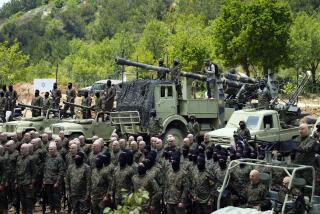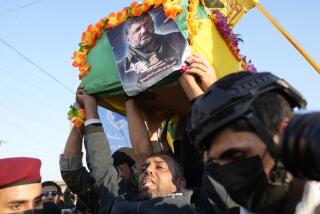Rebel Groups Could Unite Against U.S.
ZAMBOANGA CITY, Philippines — The Moro Islamic Liberation Front has at least 9,000 armed fighters in the field. The communist New People’s Army has 10,000 or more. The Abu Sayyaf gang numbers about 225.
All three rebel groups are waging war in the southern Philippines against the central government. All three are accused of acts of terrorism. But only one has become the target of the U.S. armed forces: the diminutive Abu Sayyaf.
But if the Bush administration has picked a fight it thinks is winnable, rebel leaders have a warning: Sending American troops into battle in the southern Philippines could unite the region’s insurgent forces against the United States and trigger a wider conflict.
“The American people are not our enemies, but we will take it as an invasion if they come to fight,” said Shariff-Moshin Julabbi, a leader of the Moro Islamic Liberation Front, or MILF. “There is no alternative but to fight.”
Although the exact role of the U.S. forces is still a matter of dispute, the government of President Gloria Macapagal Arroyo is eager for assistance from the United States because the Philippines’ poorly equipped military is stretched beyond its limit in fighting rebels on three fronts at once.
“We can’t do it all at the same time,” said Lt. Gen. Narciso Abaya, the commander of the southern forces who will take over as armed forces chief of staff in April.
Each of the rebel groups has a different goal. The MILF is seeking independence for the southern Philippines, where most of the country’s Muslims live. The communists are seeking to overthrow the government. And the Abu Sayyaf, a onetime Islamic separatist group now in the kidnapping business, wants money.
The Abu Sayyaf is holding at least six hostages, including four Jehovah’s Witnesses, on the rugged island of Jolo. U.S. forces are expected to be deployed to Jolo in the coming weeks.
“The terrain is favorable to the Abu Sayyaf,” Abaya said. “It’s difficult to find them. They are always on the go. They avoid direct confrontation with the army. That’s what makes this operation so hard.”
The general said the government’s strategy is to eliminate the Abu Sayyaf, seek a peace accord with the Muslim separatists and neutralize the New People’s Army.
In recent days, however, a 1 1/2-year cease-fire with the MILF has broken down and fighting has escalated. Army units overran an Islamic center that officials say was used by the rebels for military training.
The rebels countered by blowing up power lines and attacking a power station, temporarily cutting off electricity in much of the region.
Authorities say the Muslim rebels went into a village last week and killed 14 Christian civilians.
Both sides acknowledge that scores of their soldiers have been killed in a series of battles. Each blames the other for violating the truce.
MILF leader Hashim Salamat declared in a recorded message broadcast this week that the group was declaring “total war” against the government.
“The war has started already,” Julabbi said in an interview at his home in Zamboanga City.
The New People’s Army, meanwhile, has stepped up its hit-and-run attacks all over the country. The communist guerrillas have claimed responsibility for executing a governor, a congressman, mayors, judges and police chiefs. Last week, they killed the police chief of Laguna, a town less than 20 miles from Manila. The Communist Party of the Philippines, which is linked to the New People’s Army and has little in common with the Islamic rebels, warns that the arrival of U.S. troops could force its army to join in fighting the invaders.
“While the immediate tactical objective in deploying U.S. troops to Sulu [province] is to ensure the U.S. forces’ engagement in direct combat with the Abu Sayyaf, the bigger objective is their full deployment for direct combat operations against the revolutionary forces in the Philippines,” party spokesman Gregorio Rosal said in a statement this week.
The United States has listed the New People’s Army and the Abu Sayyaf as terrorist organizations but has held off on a similar designation for the Moro Islamic Liberation Front, apparently in deference to Arroyo, who did not want to upset peace negotiations.
The United States contends that the Abu Sayyaf has links with Osama bin Laden through its founder, Abdurajak Abubakar Janjalani.
Janjalani, who fought in Afghanistan against the Soviet Union, most likely joined the Al Qaeda network before returning to the Philippines, according to an attorney who once represented several Abu Sayyaf members in court.
Janjalani was also associated with Bin Laden’s brother-in-law Mohammed Jamal Khalifa, who lived in the Philippines and allegedly funneled money to the Abu Sayyaf and other militant Islamic causes. Khalifa left the country in the mid-1990s.
After police gunned down Janjalani during a December 1998 raid, the Abu Sayyaf lost its passion for Islam and turned to making money by kidnapping, including the high-profile abduction of foreign tourists from resort hotels.
Other Muslim rebel leaders now show disdain for the group. “We believe Abu Sayyaf is an unlawful organization,” Julabbi said. “They are kidnappers for ransom. They are fighting for nothing.”
Today, the MILF appears to have more connections than the Abu Sayyaf with international terrorist groups, particularly Jemaah Islamiah, the Southeast Asian terrorist organization allegedly responsible for an Oct. 12 bombing on the Indonesian island of Bali that killed 202 people.
Authorities say members of Jemaah Islamiah from Singapore, Malaysia and Indonesia trained at the MILF’s main facility, Camp Abubakar, before it was overrun by the Philippine military in 2000.
Julabbi denies that the MILF has any connection to international terrorist groups and says the Philippine group has no desire to fight American troops -- as long as they are here simply to train Philippine soldiers.
Julabbi said he has fond memories of a two-month course he took in Virginia and would like to see the United States mediate peace talks, not send troops. If the southern Philippines cannot win its independence, he suggested, it could become part of the United States.
“We like America,” he said. “Why not? We could be an American state like Hawaii.”
More to Read
Sign up for Essential California
The most important California stories and recommendations in your inbox every morning.
You may occasionally receive promotional content from the Los Angeles Times.










